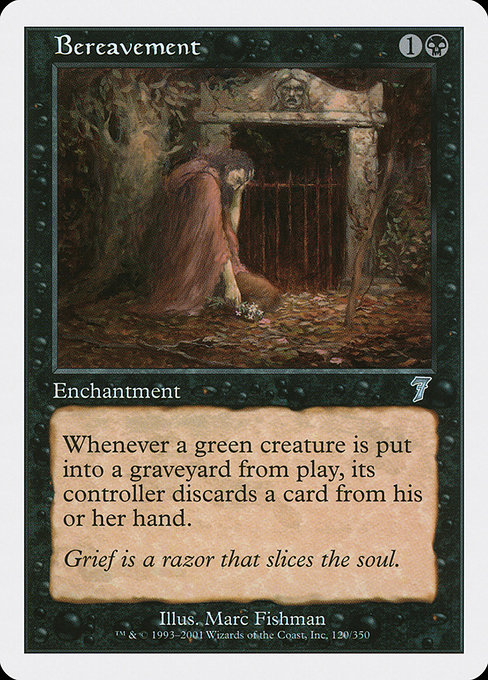
Image courtesy of Scryfall.com
Design lessons from Bereavement's creation
Magic designers often mine the margins where color identities collide, and Bereavement — a humble black enchantment from Seventh Edition — is a master class in that restraint. For a card built on a simple premise, it achieves a surprising amount of strategic texture: a two-mana aura of subtle menace that punishes a specific color’s archetype while remaining thematically faithful to black’s core priorities. Its essence lives not in a flashy beatdown line, but in the quiet pressure it applies whenever a green creature dies. 🧙♂️🔥
At first glance, the card’s engine is straightforward: an enchantment with the text “Whenever a green creature dies, its controller discards a card.” The trigger is clean, the cost is gentle — {1}{B} — and the payoff scales with the state of the board. This is a design choice that reveals a broader truth about black card design: disruption doesn’t always need to be a single hard removal spell. Sometimes, the most hauntingly effective tools are slight, recurring penalties that shape decisions over time. Bereavement gets you to lean into a particular line of play without forcing you to commit to a dramatic moment every turn. It’s the difference between a blunt hammer and a well-tuned blade. 🗡️
Reading the room: color pie, tempo, and risk
Bereavement slots neatly into black’s traditional identity—hand disruption, resource denial, and the subtle art of making opponents feel the sting of lost options. By tying its effect to green’s creatures dying, the card leans into black’s historical counterpoint to green’s creatures-and-strong-tactics ethos. It’s less about outright graveyard theft and more about pressuring decisions: if your green deck keeps its creatures alive, Bereavement stays inert; if a trade removes a green critter, the discard clock starts ticking. The tempo implication is clear but not absolute, giving the card a flexible home in various modern portfolios where raw power isn’t the sole currency of success. ⚔️
There’s also a design elegance in what Bereavement doesn’t do. It doesn’t exile, doesn’t tutor, and doesn’t hard-lock a single strategy. It punishes a family of plays—creature-based green strategies—without locking players out of the game or overshadowing other colors’ engines. In that sense, it’s a model of restraint: a card that creates meaningful friction while preserving the spirit of a broad format. The result is a piece that feels both old-school in its core idea and timeless in its applicability to a wide range of deckbuilding philosophies. 💎
Flavor, function, and the art of mood
The flavor text, “Grief is a razor that slices the soul,” anchors Bereavement in a world where emotions are as real as mana. The design team uses this line to justify the card’s presumption: grief is not a one-shot effect but a persistent penalty that reshapes the board over time. The art and flavor work in concert with the mechanic to remind players that black’s victory condition isn’t just board presence; it’s the calculation of consequences. This alignment between flavor and function is a hallmark of thoughtful card design. The synergy matters as much as the upside. 🎨
From a collector’s viewpoint, Bereavement sits in an odd but charming niche. It’s an uncommon from a core-set era, reprinted but never flashy, with a traditional frame and white border that evokes the late-1990s to early-2000s aesthetic. Its mana cost is approachable, and its rarity makes it a neat inclusion for nostalgia-driven decks that want to evoke a particular era without breaking the bank. Even in modern context, the card’s compact text and unambiguous trigger invite analysis and discussion among players who savor the era’s design language. 🧭
Practical takeaways for designers and players
- Align mechanics with color identity. Bereavement leverages black’s penchant for disruption without overstepping into outright steal-the-hand territory. When a mechanic speaks to a color, it feels earned and thematic.
- Make triggers count without complexity. A clear “Whenever a green creature dies” is easy to understand and invites multiple lines of play, especially with mass removals or sacrifice effects. Clarity fuels strategic depth.
- Scale the payoff with board state. The more green creatures die, the more impactful the effect becomes. This creates dynamic tension as players navigate the late game.
- Use flavor to justify the rule. A well-chosen flavor line helps players accept a penalty, softening what could be perceived as a punitive effect with thematic resonance. Grief isn’t just a trope; it’s a lens on the decision space.
- Design for eras, but think evergreen. Bereavement’s simple, repeatable effect remains relevant across generations of formats, teaching designers how to build timeless tools that still feel fresh when seen through modern mechanics. 🧩
For players who enjoy peeking behind the curtain, Bereavement demonstrates how a card’s design decisions ripple through gameplay. It’s a reminder that even small, well-timed nudges can tilt the balance of a match and that the most memorable cards reward careful reading and thoughtful resource management. 🧙♂️🔥
If you’re chasing a tactile reminder of well-considered design, consider pairing your exploration of classic black tricks with a practical desk upgrade. The ergonomic memory foam mouse pad with wrist rest (foot-shaped) is a savvy companion for long sessions of deck-building and analysis—comfort that helps you think bigger, longer, and with fewer distractions. Ergonomic Memory Foam Mouse Pad with Wrist Rest (Foot-Shaped) 🧙♂️🎲
More from our network
- https://transparent-paper.shop/blog/post/blue-giant-at-32482-k-illuminates-interstellar-medium/
- https://crypto-acolytes.xyz/blog/post/using-metamask-safely-practical-security-tips-for-users/
- https://blog.zero-static.xyz/blog/post/rarity-indicators-and-thundertrap-trainer-design-language/
- https://blog.digital-vault.xyz/blog/post/niche-marketing-strategies-that-drive-targeted-growth/
- https://blog.digital-vault.xyz/blog/post/steelshaper-apprentice-crafting-mighty-artifact-tokens/